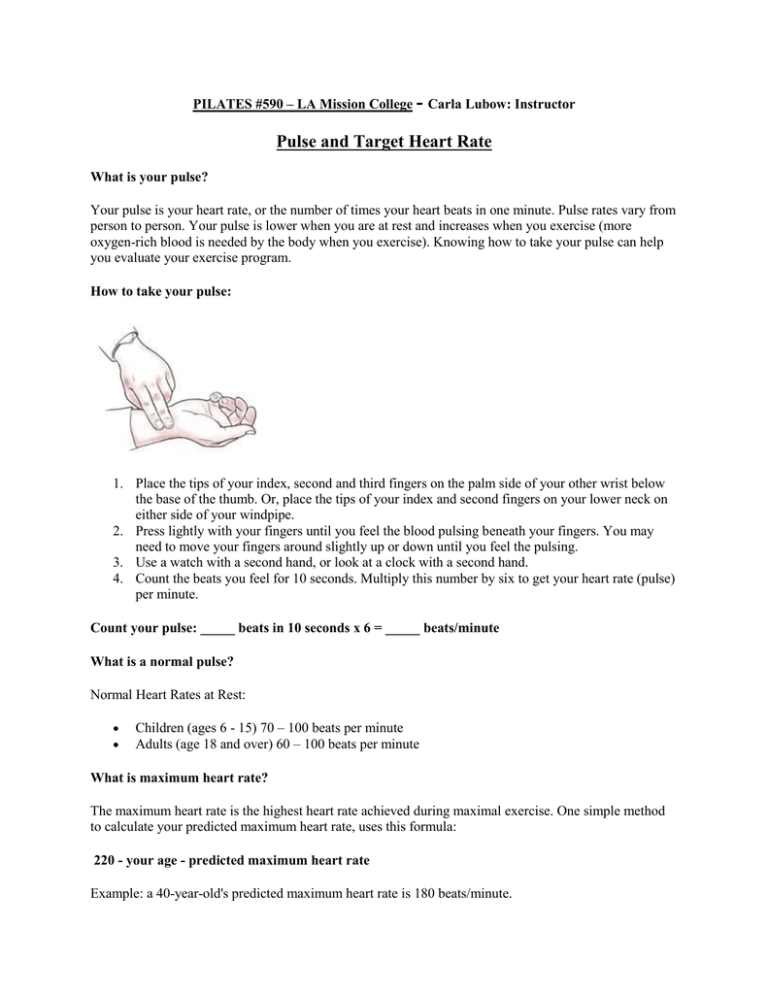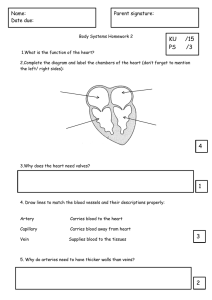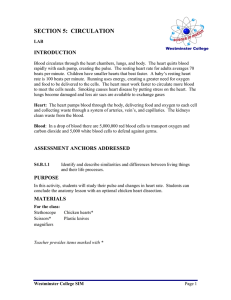TARGET HEART RATE-PilatesHandout.doc
advertisement

PILATES #590 – LA Mission College - Carla Lubow: Instructor Pulse and Target Heart Rate What is your pulse? Your pulse is your heart rate, or the number of times your heart beats in one minute. Pulse rates vary from person to person. Your pulse is lower when you are at rest and increases when you exercise (more oxygen-rich blood is needed by the body when you exercise). Knowing how to take your pulse can help you evaluate your exercise program. How to take your pulse: 1. Place the tips of your index, second and third fingers on the palm side of your other wrist below the base of the thumb. Or, place the tips of your index and second fingers on your lower neck on either side of your windpipe. 2. Press lightly with your fingers until you feel the blood pulsing beneath your fingers. You may need to move your fingers around slightly up or down until you feel the pulsing. 3. Use a watch with a second hand, or look at a clock with a second hand. 4. Count the beats you feel for 10 seconds. Multiply this number by six to get your heart rate (pulse) per minute. Count your pulse: _____ beats in 10 seconds x 6 = _____ beats/minute What is a normal pulse? Normal Heart Rates at Rest: Children (ages 6 - 15) 70 – 100 beats per minute Adults (age 18 and over) 60 – 100 beats per minute What is maximum heart rate? The maximum heart rate is the highest heart rate achieved during maximal exercise. One simple method to calculate your predicted maximum heart rate, uses this formula: 220 - your age - predicted maximum heart rate Example: a 40-year-old's predicted maximum heart rate is 180 beats/minute. What is target heart rate? You gain the most benefits and lessen the risks when you exercise in your target heart rate zone. Usually this is when your exercise heart rate (pulse) is 60 to 80 percent of your maximum heart rate. It is not recommended to exercise above 85 percent of your maximum heart rate. Intensity at that level increases both cardiovascular and orthopedic risk with minimal, additional healthrelated benefit from the exercise. To find out if your are exercising in your target zone (between 60 and 80 percent of your maximum heart rate), stop exercising and check your 10-second pulse. If your pulse is below your target zone, increase your rate of exercise. If your pulse is above your target zone, decrease your rate of exercise. What is your target zone? Target Heart Rate Zones by Age * Target Heart Rate (HR) Zone (60 Predicted Maximum Age 85%) HR 20 120 – 170 200 25 117 – 166 195 30 114 – 162 190 35 111 – 157 185 40 108 – 153 180 45 105 – 149 175 50 102 – 145 170 55 99 – 140 165 60 96 – 136 160 65 93 – 132 155 70 90 – 123 150 * This chart is based on the the formula: 220 - your age = predicted maximum heart rate




